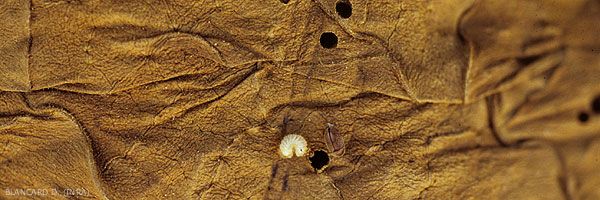
Pests of stored leaves
Several insects may attack tobacco leaves during curing and storage.
 |
 |
 |
| Figure 1 | Figure 2 | Figure 3 |
Lasioderma serricorne F. (1792) ("cigarette beetle" or "tobacco beetle") is a cosmopolitan insect, which feeds on herbs, leather, spices, dry plant material and also books. The adult beetle (Anobiidae) is brown-red. The larva is a small worm covered with white hair, that has long and powerful mandibles (figure 1). The young larvae make galleries in piles of tobacco leaves. Once the larva has reached its full development, it gets closer to the the outer areas of the piles, prior to pupation. The adult beetle emerges from the pupal chamber by making a small hole to the outside. The lifecycle from the egg stage to the adult, lasts about two months. There are more than four generations per year in warmer regions.
Ephestia elutella Turner (1915) (tobacco moth, mite or cocoa moth) is a very cosmopolitan lepidopteran insect (Pyralidae). It is able to damage a huge range of food products: cocoa, dried fruit, rice, dehydrated vegetables, green coffee beans, oilseed cakes but also harvested tobacco leaves (figure 2). Larvae of Ephestia elutella cause damage in stored tobacco leaves (figures 3 to 7). The adult has a wingspan of 14 and 18 mm (figure 7).In Europe this insect can give two generations per year in unheated rooms, but the species is multiplying much faster in warmer regions.





